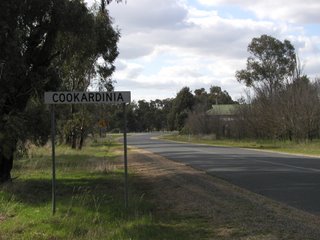
 Talbot in 1860: D. Coleman, restaurater, Scandinavian Cresent
Talbot in 1860: D. Coleman, restaurater, Scandinavian CresentThe wattles between Ballarat and Talbot were stunning. Clunes and Creswick seem intriguing places to be explored on another visit. Daniel Coleman, a brother of my great-great grandfather, married Anne Darcy, spinster, 21, born in County Tipperary, at Back Creek, Amherst (north of Ballarat), District of Carisbrook, on the 5th February 1860. Back Creek was the alternative name for what is now known as
Talbot. Amherst, about three miles from Back Creek, was the main centre of mining in the area in 1865 with about 4600 people in the vicinity. In that year Talbot had a population of about 3400 with 18 hotels, including the Nil Desperandum, the United States and All Nations!
Today there are about 300 people in Talbot but is has a good café, an interesting
museum, with committed staff who opened-up especially for my visit, an internet resource centre (open sometimes) and an intriguing bookshop (Slightly Bent Books) on the corner of Camp St and Scandinavian Crescent!
It was a worthwhile visit, however short - meeting Marie and her husband, finding a record for a D Coleman who had a restaurant on Scandinavian Crescent in 1860 – possibly Daniel?? There is often some reciprocity in these situations – from my research I was able to provide the name of the local Catholic Church, which no-one seemed to know - it had been deconsecrated many years ago and perhaps there were not too many Catholics about!!! Or perhaps no-one had been interested before – local history seems in a vulnerable condition in Australia, dependent on enthusiasts and the good will of volunteers. There seems little systematic support from local, state or Federal government – I am sure much is in danger of being lost.
















